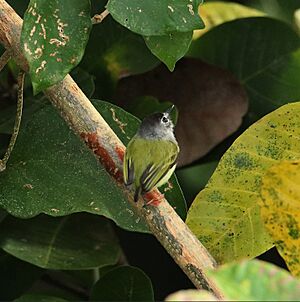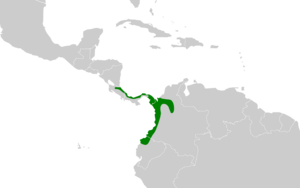Black-capped pygmy tyrant facts for kids
Quick facts for kids Black-capped pygmy tyrant |
|
|---|---|
 |
|
 |
|
| Conservation status | |
| Scientific classification | |
| Genus: |
Myiornis
|
| Species: |
atricapillus
|
 |
|
The black-capped pygmy tyrant (scientific name: Myiornis atricapillus) is a super tiny bird. It's the smallest passerine bird, which means it's a perching bird. This little tyrant flycatcher lives in Central and South America. You can find it from Costa Rica all the way to north-western Ecuador.
Contents
Discover the Black-capped Pygmy Tyrant
This amazing bird is a type of tyrant flycatcher. It's known for being incredibly small. In fact, it's the smallest perching bird in the areas where it lives. It's even smaller than its relative, the short-tailed pygmy tyrant.
Where Does This Tiny Bird Live?
The black-capped pygmy tyrant loves to live in the tops of trees. These tall trees form a "canopy" in the forest. You might also spot them at the edges of forests or in clearings. They also like areas with new tree growth, called "second growth." Sometimes, they live in semi-open woodlands too.
They prefer places that are not too high up. You'll usually find them below 900 meters (about 3,000 feet) in altitude. They are quite common in many areas. However, they don't like very dry places. In Costa Rica and most of Panama, they stick to the lowlands near the Caribbean Sea. Further south, in a region called El Chocó, they prefer humid, wet areas.
What Does a Black-capped Pygmy Tyrant Look Like?
This bird is truly tiny! It's only about 6.5 centimeters (2.5 inches) long. That's shorter than your finger! It weighs just about 5.2 grams, which is less than a nickel.
Its head has a black cap on top. This black color fades into dark grey on the rest of its head. It has cool white "spectacles" around its eyes. The rest of its back and upper body are olive-green. Its tail and wings are dark, almost black. But they have bright yellow edges on the feathers. You'll also see two yellow stripes on its wings.
The throat and the middle of its chest are white. This color changes to grey on its sides. Its belly is a pale yellow. Both male and female birds look similar. However, females might have a slightly duller black cap. Young birds have a browner cap and back. Their wing markings and underparts might also have a buff (light brownish-yellow) color.
How Does This Bird Behave?
You can often see black-capped pygmy tyrants alone. Sometimes, they are in pairs or small family groups. They are very active hunters. They catch small insects by making quick, darting movements. They fly out fast to grab an insect, then return to their perch.
Nesting and Eggs
The female black-capped pygmy tyrant is a skilled builder. She creates a unique nest that looks like a long pouch. It's about 15 centimeters (6 inches) long. The nest has a round entrance on the side. She hangs this pouch nest from a thin tree branch. It's usually placed between 1 and 7 meters (3 to 23 feet) high in a tree.
After building the nest, the female lays two eggs. The eggs are white with brown spots or blotches. She sits on the eggs to keep them warm. This is called incubation. The eggs hatch after about 15 to 16 days.
What Does It Sound Like?
The call of the black-capped pygmy tyrant is a thin ttseep sound. It's so high-pitched that it can sometimes sound like an insect or even a frog! When they are in family groups, they also use soft whistles and trills to talk to each other.


